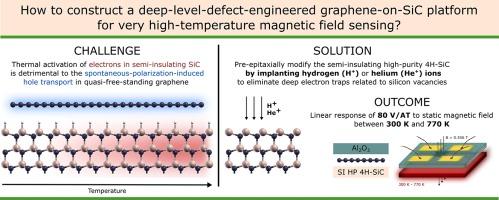Defect-engineered graphene-on-silicon-carbide platform for magnetic field sensing at greatly elevated temperatures
Abstract
High-temperature electrical properties of p-type hydrogen-intercalated quasi-free-standing epitaxial Chemical Vapor Deposition graphene on semi-insulating vanadium-compensated on-axis 6H-SiC(0001) and high-purity on-axis 4H-SiC(0001) originate from the double-carrier system of spontaneous-polarization-induced holes in graphene and thermally-activated electrons in the substrate. In this study, we pre-epitaxially modify SiC by implanting hydrogen (H+) and helium (He+) ions with energies ranging from 20 keV to 50 keV to reconstruct its post-epitaxial defect structure and suppress the thermally-developed electron channel. Through a combination of dark current measurements and High-Resolution Photo-Induced Transient Spectroscopy between 300 K and 700 K, we monitor the impact of ion bombardment on the transport properties of SiC and reveal activation energies of the individual deep-level defects. We find that the ion implantation has a negligible effect on 6H-SiC. Yet in 4H-SiC, it shifts the Fermi level from ∼600 meV to ∼800 meV below the minimum of the conduction band and reduces the electron concentration by two orders of magnitude. Specifically, it eliminates deep electron traps related to silicon vacancies in the charge state (2-/-) occupying the h and k sites of the 4H-SiC lattice. Finally, we directly implement the protocol of deep-level defect engineering in the technology of amorphous-aluminum-oxide-passivated Hall effect sensors and introduce a mature sensory platform with record-linear current-mode sensitivity of approximately 80 V/AT with -0.03-%/K stability in a broad temperature range between 300 K and 770 K, and likely far beyond 770 K.


| 公司名称 | 产品信息 | 采购帮参考价格 |
|---|
 求助内容:
求助内容: 应助结果提醒方式:
应助结果提醒方式:


